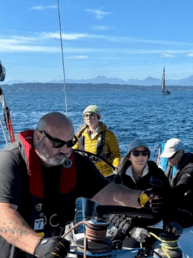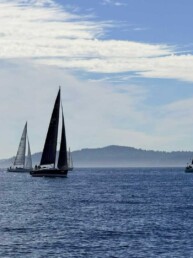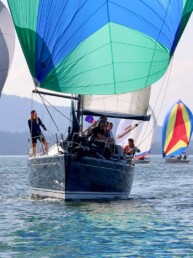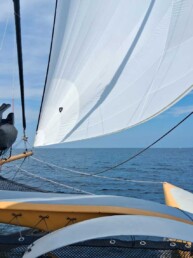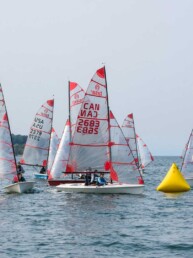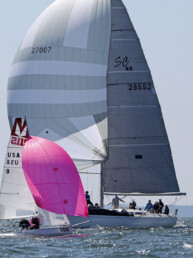What a lot went down in the 36 hours since the start of Race to Alaska. That’s the time limit for the leg known as the “Proving Ground” that brings sailors from Port Townsend across to Victoria – 36 hours. Flat calm, rain, sun, fog, haze, day, night, and, most poignantly, a monster Juan de Fuca gale smack dab in the middle. Fast human power, some slow progress under sail (thanks to both light wind and heavy air), and several scary and necessary rescues made for a most memorable first leg. A lot went down, but thankfully no boats and, infinitely more important, no sailors.
I admit to have pondered the thought, ‘will the phenomenal enthusiasm for R2Ak wane eventually?’ The last 36 hours have shown me why I see no end to the drama in sight; why I refreshed the tracker more times than I can count; why a young couple I didn’t know were watching R2AK videos on their phone at the table next to me in a landlocked watering hole last night.
We’re a sailing publication, but let me first note my genuine glee that human power bested sail on Thursday. Congratulations to Team Liteboat, Team Take me to the Volcano, and Team Angus Rowboats for rounding out the podium of leg one! For any R2AK fan, the possibility that rowing, paddling, or pedaling might compete evenly with sail has always made the race intriguing. We haven’t seen human power come particularly close until yesterday, although looking back at the Soggy Beavers run in 2015 is all the more impressive now. I love yesterday’s outcome, though it makes me disappointed that none of the top three will continue on to Ketchikan this year. However, finisher #4, Team Oaracle, is doing the full race!
For the R2AK sailors, the experiences were certainly varied. Prior to departure, the Ruckus and docks had been abuzz with talk about the potential front that would come in the afternoon on Thursday, and come it most certainly did. From my vantage point on the committee boat, I watched the spinnaker-driven boats slowly slip out of sight in the early morning, wondering if and when the wind would hit as forecast. About five hours later, the Juan de Fuca westerly turned on like whoa. I’ve now had direct communication with a couple teams, so read on to hear the stories of Team Freeburd/Pure & Wild, Team KELP, and Team West Coast Wild Ones.
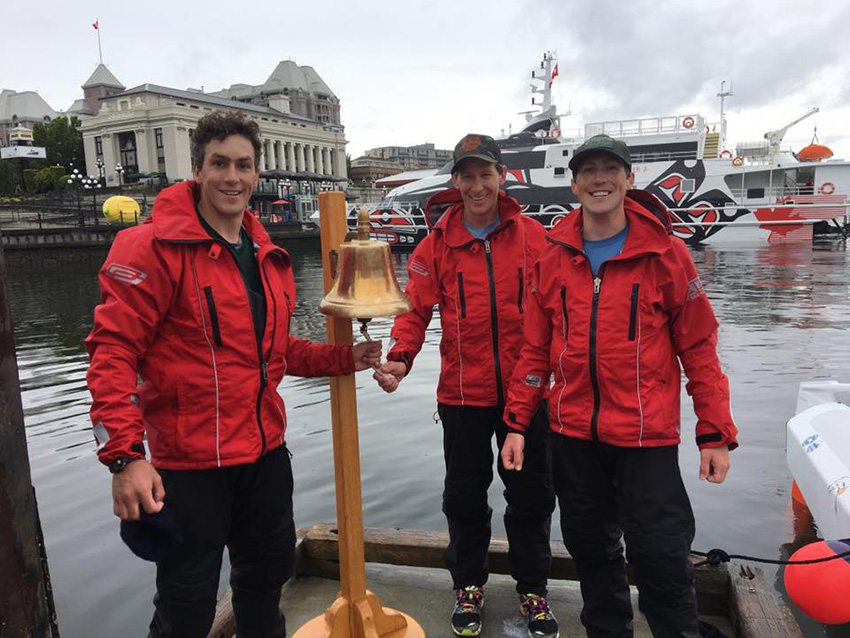
Team Freeburd/Pure & Wild
A couple of the early teams barely saw any breeze. The first sailboat to finish was the accomplished trio of brothers of Team Freeburd/Pure & Wild on their borrowed Melvin and Morelli trimaran that was sailed by a different crew in 2016, but was also last year’s Pure & Wild boat. They were closely followed by the Multi 23 Trimaran, Team Pear Shaped Racing; Port Townsend boat building guru, Russell Brown, on Team Port Townsend Watercraft; as well as other race favorites like Bad Kitty and Broderna. Most of these early arrivers missed the worst of the weather. In fact, the Burd brothers never saw breeze above 10 knots, and only saw that 8-10 knots in the last couple of miles.
I got a chance to talk with Freeburd/Pure & Wild on Friday, and they were really pleased with much of their day had gone. First off, they told me they were “really happy with the pedal drive, but it was a reality check about how difficult it will still be if there’s no wind.” In flat water and no breeze, they were able to do 3.8-4 knots under pedal drive alone, which was very impressive to me. The went on, “We were also using some standup paddleboard paddles, and with those, we could maintain 4 knots fairly easily. When the breeze filled slightly, we ‘motor sailed’ until we were going a solid 6 knots and then switched fully to sail.”
Freeburd crossed tacks and had lead changes with Broderna, Bad Kitty, Pear Shaped, PT Watercraft, and Turn Point Design. Eventually, there was a split and the others went toward the San Juans, while Freeburd and Pear Shaped went further out into the Strait. They caught the first of the westerlies, and said, “In the end, it’s still a sailboat race, and there were monster gains if you were in the right place at the right time.” However, even as the westerly filled and they realized they had been on the right side of the breeze in this case, “the human-powered leaders were just dots on the horizon.”
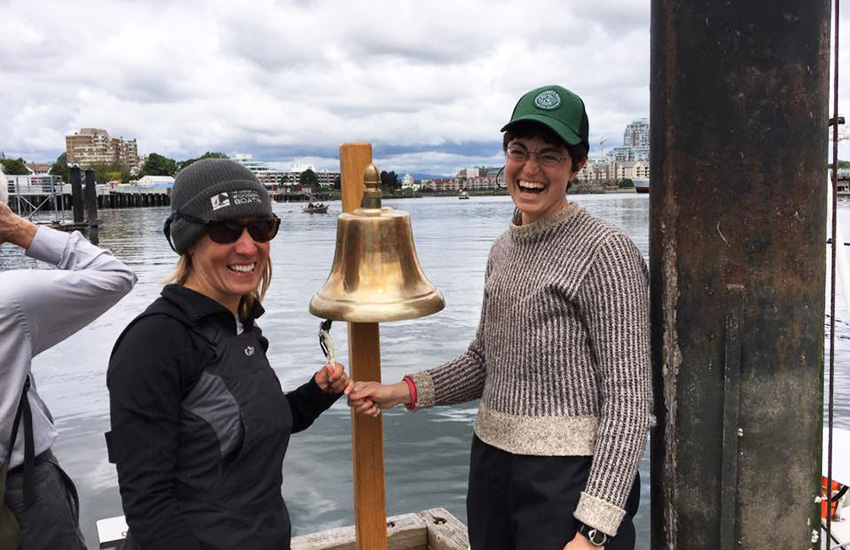
Team KELP
The dynamic duo of Team KELP, who are racing a Santana 20, could literally see the entrance to Victoria Harbor when the wind build so fast they had to tuck in a reef. Once they got that sorted, they were in Discovery Bay and the wind had gone to gale force. From there, it was full-on battle.
Like everyone else, it had been slow going in the early part of the day for KELP. Kristin said, “We could have rowed more than we chose to. We piddled along and had the spinnaker up for a bit. We were expecting the southerly to push us in before the westerly filled.”
Elena continued, “We were within eight miles of the finish when the wind hit. We were SO CLOSE! We were sailing with the full main and medium jib, which is about a 120. By the time we were reefed and had put up the small jib, it was so windy we were just trying not to go backwards. The last forecast we had seen called for it to die after a few hours, and we thought we could out last it. We did this for five hours, going basically nowhere. Eventually, we took our jib down and sailed under main alone, and that was more comfortable. We realized we could heave-to under main alone, and hung out like that for at least a half hour of rest. Our boat is amazing! Truly, the boat was a rockstar, a champion.”
When I asked about the sea state, Kristin described one particular tense moment: “We tried to duck behind some rocks at one point, and that turned out to be a really bad idea, like a disaster. There were standing waves from every direction. We wound up with no steerage, quickly coming up on a lee shore.”
Elena said of that experience tucked behind the rocks, “That was the one moment where I felt genuine fear. We couldn’t control the boat and we were going to be up on an island soon. I thought, ‘this is how these stories happen.'”
They resolved this near-disaster by heavily roll-tacking the boat in the waves and backwinding the jib. The described being, “totally together in our plan and movements.” One they were out in the strait again, Kristin said, “it was chunky, and there was the occasional breaking wave, but it was less dramatic.”
After these hours of heavy air position-holding, they got an updated forecast that now had the gale continuing until 9:00pm. The decided they wouldn’t continue, and didn’t want to be making that final push in the dark after ten hours of exhausting position-holding. They turned away from the breeze and sailed down to Oak Bay, where the breeze was significantly lighter. They turned the corner for the marina, saw three other R2AK boats, and an open spot at the dock. They got so excited and relieved they nearly forgot what they were doing and narrowly missed going aground in their understandable ebullience. Their husbands had a hotel room, and they gladly took the ride into town for the opportunity to shower off the caked salt and get some real rest.
All the while, though, both members of Team KELP were consumed by worry for the other teams. They had been monitoring their VHF the whole time, but given their position, they were picking up the Canadian Coast Guard calls, but couldn’t hear most of the calls or responses from the other racers. They hears the calls for person in the water and another for capsized sailing vessel. There was a helicopter. Elena said, “I had this moment when I thought, ‘someone could die out here today.'” They were right that the conditions were that severe, but thankfully all are safe.
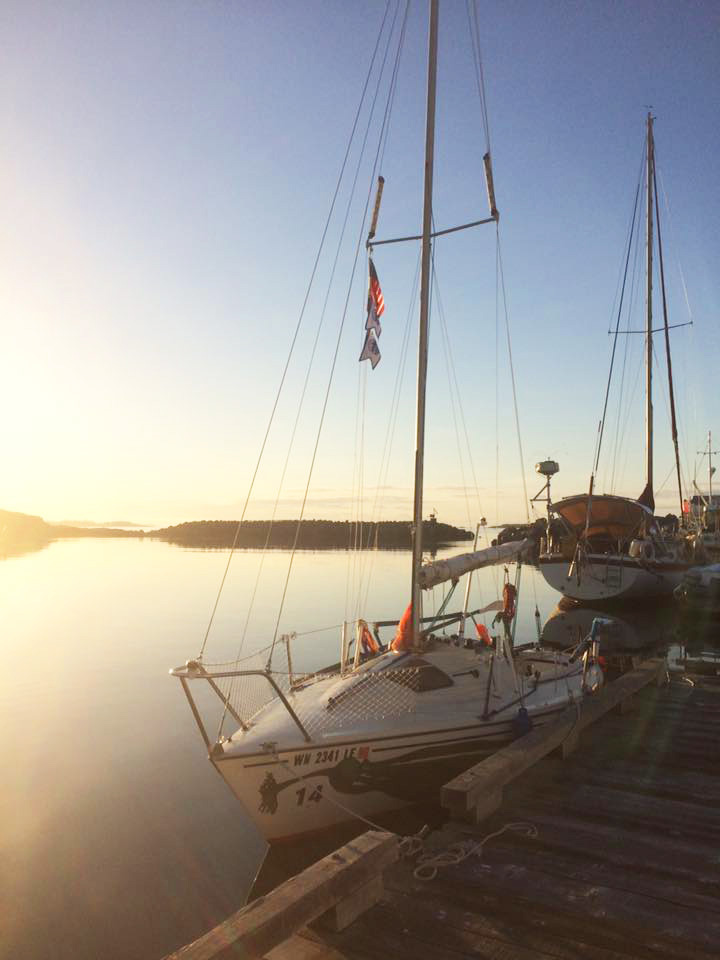
When they arrived back to the boat around 6:00am on Friday morning, it was a completely different scene. A haze hung in the golden sunrise light, and there wasn’t a whisper of wind in the marina. They made good time getting over to Victoria from Oak Bay, and were basically on track to make the 10:00am hotel breakfast. They said, “We were excited to use the ebb to get to the harbor entrance, but we hadn’t thought about having to row against it to get into the harbor. We rowed and rowed, and ended up exhausted at the fuel dock just before max ebb. We dropped sails at 8:45, we were at the fuel dock at 9:20. Elena rowing, Kristin paddling. We needed both of us. When we got to the fuel dock, the attendant told us we couldn’t stay there. We gave him a look that indicated we weren’t moving, and we also gave him bag of chocolate. He looked the other way. We were on the fuel dock for 45 minutes to rest and let the ebb reduce slightly.”
Team KELP are one of the few teams that had no equipment problems after being out in the gale. Perhaps their biggest issues were a tablet navigation issue, unrelated to the wind, and the discovery that Elena’s seven-year-old foulie pants are no longer waterproof. Each of these is a good first leg discovery, because each issue has been resolved in Victoria.
With pride in her voice, Elena summed up her experience beautifully: “We made really good decisions today. We didn’t break anything. We didn’t rip any sails. We’re not hurt. We did it! We learned a lot. And staying out of weather like that is much more of a priority for me now.”
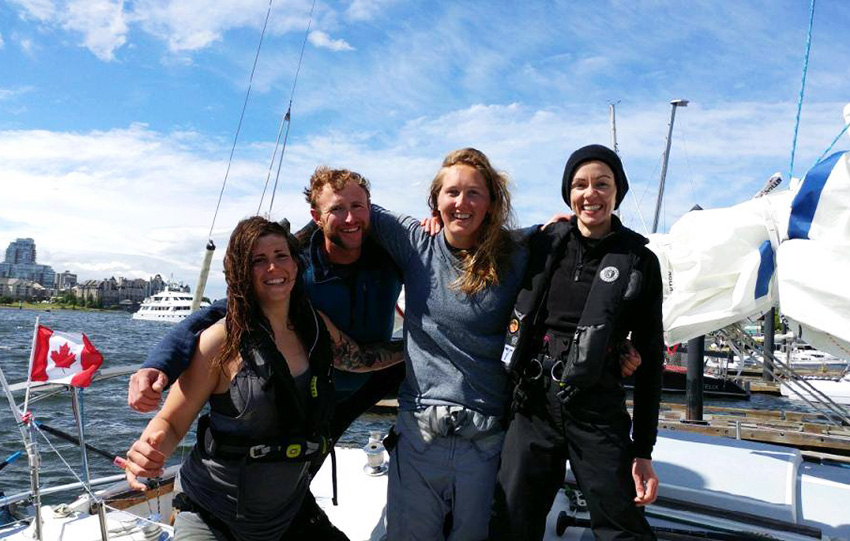
Team West Coast Wild Ones
I didn’t have a chance to speak with these wily sailors directly yet, but they sent me the following report:
The race began with light rain and wind on a broad reach. We rowed with an asymmetrical spinnaker up. The current was pushing us alongmore than the sail or oars. We cut close to Point Wilson and encountered the tide rips – wet rowing!
We took the SW route around the traffic separation junction, staying high and parallel to the shipping lane in the Strait of Juan de Fuca to avoid getting pulled into Discovery Bay.
We rowed and progressively sailed along this course, then set ourselves up on the rhumb line. This would have set us to enter Victoria Farbour had we not been caught with our 150 genoa as the gale turned on. In a matter of 10 minutes we made two sail changes and two reefs.
Beating to windward 75 degrees off the gale force winds in approximately three meter seas and an adverse current, we made minimal headway. Eventually a long tack heading into the current and putting distance between us and the lee shore set us up to just clear the breakwater into Victoria Harbour.
We dropped the main and continued under a #4 jib, past the “no sail” zone, knowing we had more control under sail in these conditions. Once the police boat flagged us down, we continued under bare poles at 4 knots and used out oars to slow us, having the dock crew catch out stern line and bring us to an abrupt stop.
We were the first to come in under gale conditions, third of the monohulls. We are very proud of our 1972 O’Day 27 cruiser!
There are many more stories from this leg, including those of teams that had more trouble. As we hear from them, please check back with for more details at www.48north.com.
Joe Cline is the Editor of 48° North.
Joe Cline
Joe Cline has been the Managing Editor of 48° North since 2014. From his career to his volunteer leadership in the marine industry, from racing sailboats large and small to his discovery of Pacific Northwest cruising —Joe is as sail-smitten as they come. Joe and his wife, Kaylin, have welcomed a couple of beautiful kiddos in the last few years, and he is enjoying fatherhood while still finding time to make a little music and even occasionally go sailing.

